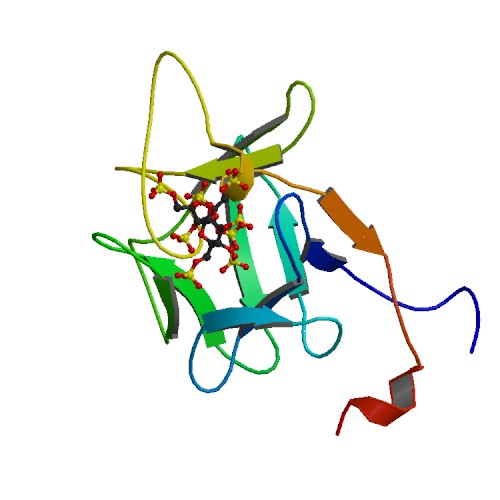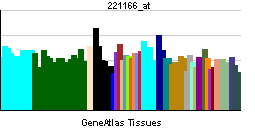Fibroblast growth factor 23
| Fibroblast growth factor 23 | |||||||||||||
|---|---|---|---|---|---|---|---|---|---|---|---|---|---|
 PDB rendering based on 2p39. | |||||||||||||
| |||||||||||||
| Identifiers | |||||||||||||
| Symbols | FGF23 ; ADHR; HYPF; HPDR2; PHPTC | ||||||||||||
| External IDs | Template:OMIM5 Template:MGI HomoloGene: 10771 | ||||||||||||
| |||||||||||||
| RNA expression pattern | |||||||||||||
 | |||||||||||||
| More reference expression data | |||||||||||||
| Orthologs | |||||||||||||
| Template:GNF Ortholog box | |||||||||||||
| Species | Human | Mouse | |||||||||||
| Entrez | n/a | n/a | |||||||||||
| Ensembl | n/a | n/a | |||||||||||
| UniProt | n/a | n/a | |||||||||||
| RefSeq (mRNA) | n/a | n/a | |||||||||||
| RefSeq (protein) | n/a | n/a | |||||||||||
| Location (UCSC) | n/a | n/a | |||||||||||
| PubMed search | n/a | n/a | |||||||||||
Fibroblast growth factor 23 or FGF23 is gene which is a member of the fibroblast growth factor (FGF) family and encodes a protein which is responsible for phosphate metabolism.
FGF family members possess broad mitogenic and cell survival activities and are involved in a variety of biological processes including embryonic development, cell growth, morphogenesis, tissue repair, tumor growth and invasion. The product of this gene inhibits renal tubular phosphate transport.
FGF23 is located on chromosome 12 and is composed of three exons. Mutations in FGF23 which cause failure of proper gene splicing leads to increased activity of FGF23 and the renal phosphate loss found in the human disease autosomal dominant hypophosphatemic rickets. FGF23 is also overproduced by some types of tumors, causing tumor-produced osteomalacia. Loss of FGF23 activity is thought to lead to increased phosphate levels and the clinical syndrome of familial tumor calcinosis.
There is evidence for a hormone/enzyme/extracellular matrix protein cascade involving fibroblastic growth factor 23 (FGF23), the X-linked phosphate regulating endopeptidase homolog (PHEX), and a matrix extracellular phosphoglycoprotein (MEPE) that regulates systemic phosphate homeostasis and mineralization.[1] Short-term infusion of MEPE inhibits phosphate absorption in the jejunum but not the duodenum.[2] The short-term inhibitory effect of MEPE on renal and intestinal phosphate handling occurs without any changes in circulating levels of parathyroid hormone (PTH), 1,25-dihydroxyvitamin D3, or fibroblast growth factor 23 (FGF23).[2] MEPE may be involved in phosphate homeostasis, acting in both the kidney and the gastrointestinal tract.[2]
This gene was identified by its mutations associated with autosomal dominant hypophosphatemic rickets.[3] Prior to discovery in 2000, it was hypothesized that a protein existed which performed the function of FGF23. This putative protein was known as phosphatonin.
Fibroblast Growth Factor 23 (FGF-23) and Secondary Hyperparathyroidism
The mechanism of fibroblast growth factor 23 (FGF-23) in chronic renal disease and development of secondary hyperparathyroidism is as follows:[4]
- FGF-23 is a hormone produced in the osteocytes and osteoblasts.
- Its production is increased due to high serum phosphate and high calcitriol.
- FGF-23 binds and activates a receptor called fibroblast growth factor receptor 1 (FGFR1).
- FGFR1 is functional when co-expressed with the Klotho transmembrane protein, as a Klotho-FGF receptor complex.
- FGF-23 reduces the expression of type II sodium phosphate co-transporters (NaPi-2a and NaPi-2c) decreasing phosphate reabsorption in proximal tubules.
- In chronic renal failure, as a result, phosphate absorption is increased in proximal tubules due to effect of FGF-23 as well as increased parathyroid hormone. This is responsible for normal serum phosphate levels in majority of patients until the glomerular filtration rate (GFR) falls below 20 ml/min.
- As chronic renal failure progresses, these negative feedback loops are impaired leading to deranged phosphate homeostasis.
- FGF-23 have direct and indirect effect on parathyroid hormone.
- Direct effect: In normal parathyroid gland, FGF-23 decreases synthesis of parathyroid hormone through the mitogen-activated protein kinase (MAPK) pathway.[5] FGF-23 increases expression of the parathyroid calcium-sensing receptor and the vitamin D receptor, and reduces cellular proliferation.[6]
- Indirect effect: Increased synthesis of parathyroid hormone by decreasing synthesis of calcitriol.
- FGF-23 fails to activate mitogen-activated protein kinase pathway in hyperplastic parathyroid gland secondary to chronic renal failure.[6]
References
- ↑ Quarles LD (2003). "FGF23, PHEX, and MEPE regulation of phosphate homeostasis and skeletal mineralization". Am J Physiol Endocrinol Metab. 285 (1): E1–9. PMID 12791601. Unknown parameter
|month=ignored (help) - ↑ 2.0 2.1 2.2 Marks J, Churchill LJ, Debnam ES, Unwin RJ (2008). "Matrix extracellular phosphoglycoprotein inhibits phosphate transport". J Am Soc Nephrol. 19 (12): 2313–20. PMID 19005008. Unknown parameter
|month=ignored (help) - ↑ "Entrez Gene: FGF23 fibroblast growth factor 23".
- ↑ Cunningham J, Locatelli F, Rodriguez M (2011). "Secondary hyperparathyroidism: pathogenesis, disease progression, and therapeutic options". Clin J Am Soc Nephrol. 6 (4): 913–21. doi:10.2215/CJN.06040710. PMID 21454719.
- ↑ Ben-Dov IZ, Galitzer H, Lavi-Moshayoff V, Goetz R, Kuro-o M, Mohammadi M, Sirkis R, Naveh-Many T, Silver J (2007). "The parathyroid is a target organ for FGF23 in rats". J. Clin. Invest. 117 (12): 4003–8. doi:10.1172/JCI32409. PMC 2066196. PMID 17992255.
- ↑ 6.0 6.1 Canalejo R, Canalejo A, Martinez-Moreno JM, Rodriguez-Ortiz ME, Estepa JC, Mendoza FJ, Munoz-Castaneda JR, Shalhoub V, Almaden Y, Rodriguez M (2010). "FGF23 fails to inhibit uremic parathyroid glands". J. Am. Soc. Nephrol. 21 (7): 1125–35. doi:10.1681/ASN.2009040427. PMC 3152229. PMID 20431039.
Further reading
- Silve C, Beck L (2003). "Is FGF23 the long sought after phosphaturic factor phosphatonin?". Nephrol. Dial. Transplant. 17 (6): 958–61. PMID 12032180.
- Quarles LD (2003). "FGF23, PHEX, and MEPE regulation of phosphate homeostasis and skeletal mineralization". Am. J. Physiol. Endocrinol. Metab. 285 (1): E1–9. doi:10.1152/ajpendo.00016.2003. PMID 12791601.
- Fukagawa M, Nii-Kono T, Kazama JJ (2005). "Role of fibroblast growth factor 23 in health and in chronic kidney disease". Curr. Opin. Nephrol. Hypertens. 14 (4): 325–9. PMID 15930999.
- Imel EA, Econs MJ (2006). "Fibroblast growth factor 23: roles in health and disease". J. Am. Soc. Nephrol. 16 (9): 2565–75. doi:10.1681/ASN.2005050573. PMID 16033853.
- Liu S, Quarles LD (2007). "How fibroblast growth factor 23 works". J. Am. Soc. Nephrol. 18 (6): 1637–47. doi:10.1681/ASN.2007010068. PMID 17494882.
- Yamashita T, Yoshioka M, Itoh N (2000). "Identification of a novel fibroblast growth factor, FGF-23, preferentially expressed in the ventrolateral thalamic nucleus of the brain". Biochem. Biophys. Res. Commun. 277 (2): 494–8. doi:10.1006/bbrc.2000.3696. PMID 11032749.
- "Autosomal dominant hypophosphataemic rickets is associated with mutations in FGF23". Nat. Genet. 26 (3): 345–8. 2000. doi:10.1038/81664. PMID 11062477.
- White KE, Jonsson KB, Carn G; et al. (2001). "The autosomal dominant hypophosphatemic rickets (ADHR) gene is a secreted polypeptide overexpressed by tumors that cause phosphate wasting". J. Clin. Endocrinol. Metab. 86 (2): 497–500. PMID 11157998.
- Shimada T, Mizutani S, Muto T; et al. (2001). "Cloning and characterization of FGF23 as a causative factor of tumor-induced osteomalacia". Proc. Natl. Acad. Sci. U.S.A. 98 (11): 6500–5. doi:10.1073/pnas.101545198. PMID 11344269.
- Bowe AE, Finnegan R, Jan de Beur SM; et al. (2001). "FGF-23 inhibits renal tubular phosphate transport and is a PHEX substrate". Biochem. Biophys. Res. Commun. 284 (4): 977–81. doi:10.1006/bbrc.2001.5084. PMID 11409890.
- White KE, Carn G, Lorenz-Depiereux B; et al. (2002). "Autosomal-dominant hypophosphatemic rickets (ADHR) mutations stabilize FGF-23". Kidney Int. 60 (6): 2079–86. doi:10.1046/j.1523-1755.2001.00064.x. PMID 11737582.
- Kruse K, Woelfel D, Strom TM, Storm TM (2002). "Loss of renal phosphate wasting in a child with autosomal dominant hypophosphatemic rickets caused by a FGF23 mutation". Horm. Res. 55 (6): 305–8. PMID 11805436.
- Yamashita T, Konishi M, Miyake A; et al. (2002). "Fibroblast growth factor (FGF)-23 inhibits renal phosphate reabsorption by activation of the mitogen-activated protein kinase pathway". J. Biol. Chem. 277 (31): 28265–70. doi:10.1074/jbc.M202527200. PMID 12032146.
- Saito H, Kusano K, Kinosaki M; et al. (2003). "Human fibroblast growth factor-23 mutants suppress Na+-dependent phosphate co-transport activity and 1alpha,25-dihydroxyvitamin D3 production". J. Biol. Chem. 278 (4): 2206–11. doi:10.1074/jbc.M207872200. PMID 12419819.
- Strausberg RL, Feingold EA, Grouse LH; et al. (2003). "Generation and initial analysis of more than 15,000 full-length human and mouse cDNA sequences". Proc. Natl. Acad. Sci. U.S.A. 99 (26): 16899–903. doi:10.1073/pnas.242603899. PMID 12477932.
- Bai XY, Miao D, Goltzman D, Karaplis AC (2003). "The autosomal dominant hypophosphatemic rickets R176Q mutation in fibroblast growth factor 23 resists proteolytic cleavage and enhances in vivo biological potency". J. Biol. Chem. 278 (11): 9843–9. doi:10.1074/jbc.M210490200. PMID 12519781.
- Larsson T, Zahradnik R, Lavigne J; et al. (2003). "Immunohistochemical detection of FGF-23 protein in tumors that cause oncogenic osteomalacia". Eur. J. Endocrinol. 148 (2): 269–76. PMID 12590648.
- Campos M, Couture C, Hirata IY; et al. (2003). "Human recombinant endopeptidase PHEX has a strict S1' specificity for acidic residues and cleaves peptides derived from fibroblast growth factor-23 and matrix extracellular phosphoglycoprotein". Biochem. J. 373 (Pt 1): 271–9. doi:10.1042/BJ20030287. PMID 12678920.
| This protein-related article is a stub. You can help Wikipedia by expanding it. |
This article incorporates text from the United States National Library of Medicine, which is in the public domain. Template:WikiDoc Sources